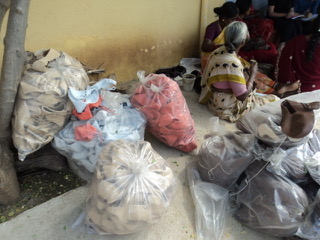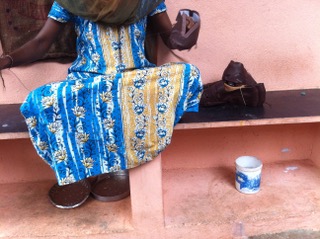Barriers to grievance: leather footwear homeworkers in Tamil Nadu, South India
by Dr Annie delaney
This case study focuses on predominantly women homeworkers engaged in the footwear supply chain in Tamil Nadu, India. UK companies found to be sourcing in this area at the time of research include Marks and Spencer, Asda/Walmart, Base London, Next, Pentland and Clarks.
Issues: Homebased workers in this industry face low wages, insecure and precarious work, and lack of freedom of association. There are numerous governance gaps identified in relation to the implementation of national legislation, international standards, and voluntary codes of conduct, that are contributing to the barriers workers face to raise a grievance and to seek redress. Leather footwear homeworkers face multiple barriers to organising themselves and asserting their rights and the international NGOs interested in supporting them have faced challenges in coordinating with each other and with local civil society partners. This case study highlights the barriers that prevent homeworkers making claims and seeking redress through the various parties and companies engaged in the global footwear supply chain.
Non-judicial redress mechanisms: Homeworkers have not been party to any formal complaint process; however, directly and indirectly, their association with social movement campaigns through NGOs has drawn them into contact with transnational footwear corporations. The case follows the responses of transnational business to the social movement campaigns on child labour in the Indian footwear sector; a homework program in North India by the ETI; and a recent campaign on leather footwear homework in Tamil Nadu.
We find that business at the transnational and operational levels grievance management strategies discussed in relation to the homework case are vague, ambiguous and not known to workers. NGOs and unions are not aware of mechanism grievance processes, and even when they are, they question the legitimacy of mechanisms because they believe that pursuing complaints is not likely to be taken seriously or conducted in a timely manner. An overall finding from this report is that a lack of recognition and dialogue with unions and civil society by corporations around accountable and transparent grievance processes perpetuates barriers to grievance for workers in the footwear supply chain. This case also highlights the potential for adverse effects from international campaigns that are not embedded in or reflect the specific interests of workers in a particular part of the supply chain.
The executive summary of this report can be read below.
Executive Summary
The challenges for transnational business to prevent human rights abuses in their global supply chains are many. At the same time systemic causes of human rights abuses in supply chains prevent workers being able to raise grievances. This report analyses the effectiveness of grievance strategies and the responses from transnational business in relation to women homeworkers in the leather footwear industry in Tamil Nadu, South India.
Globalisation provides firms with opportunities to access new product and labour markets. However, it also creates greater vulnerabilities for workers. The practices associated with outsourcing and subcontracting, driven by brand purchasing policies to secure a low price, frequently result in marginalising informal homeworkers situated at the bottom of global supply chains. Subcontracting is a feature of the global leather footwear industry, which shares many characteristics with the garment industry. Transnational business (brands) source raw leather and finished products through supply chains that rely upon labour-intensive production in developing countries. The brands are dependent upon sourcing in low-waged countries among predominantly women workers who work for low wages in poor working conditions, in factories, small workshops, and at home. In South India, the Chennai–Ambur regions are a major leather footwear industrial cluster in Tamil Nadu India. The industry is largely export oriented and is reliant on homework as part of the production of hand-stitched men’s shoes and to a lesser extent women’s leather footwear.
The research focus on women homeworker grievance is important because it presents an opportunity to explore the effectiveness of grievance strategies in relation to women workers that are working in informal work arrangements. Corporations have used various strategies to negate homeworkers’ presence, declaring the work to be of lesser value and depicting it as not ‘real’ work. The reluctance by global brands and local suppliers to acknowledge the homeworkers in the supply chain reinforces existing gender inequalities. The women homework workforce is paid below minimum wage, receives no social benefits, and works by result on piece rates, all of which contributes to the isolation and marginalisation homeworkers experience. The research on homework aims to draw out lessons for non-judicial mechanisms and civil society actors as a means to improve brands’ and suppliers’ capacity to address homeworkers’ grievances and access to remedy.
By exploring the women homeworkers’ situation, we begin to understand how their presence in the supply chain is characterised by lack of visibility, isolation, and disempowerment. The women workers’ perception of their lack of power and sense of rights is shaped by the dynamics they experience in their village, in their interactions with their husbands and families and with the suppliers and contractors who give them work. These power structures go some way to explain why they have not pursued any informal or formal grievance toward local and transnational companies in relation to human rights abuses.
Homeworkers have not been party to any formal complaint process; however, directly and indirectly, their association with social movement campaigns through NGOs has drawn them into contact with transnational footwear corporations. The research has adopted a broad approach to grievance to include grievance raised through social movement campaigns. The research follows the responses of transnational business to the social movement campaigns on child labour in the Indian footwear sector; a homework program in North India by the ETI; and a recent campaign on leather footwear homework in Tamil Nadu.
The global footwear corporations identified in this research are represented through three types of non-state voluntary, non-binding, non-judicial mechanisms:
- Corporate-designed voluntary mechanism commonly referred to as codes of conduct
- Industry-led Business Social Compliance Initiative (BSCI)
- Multi-stakeholder Ethical Trading Initiative (ETI)
We analyse the ways in which transnational business has responded to labour rights abuses linked to homework in their supply chain and the grievance management strategies through the corporate, industry, and multi-stakeholder mechanisms. The research finds that leather footwear transnational business is largely aimed at monitoring and audits in direct supplier factories also referred to as first tier suppliers. Workers beyond the first tier supplier, those employed by companies that the first tier supplier subcontracts to, tend to be employed on short-term contracts or under other precarious or vulnerable working conditions, and in extreme cases child labour is used.
Our analysis shows that footwear brands and suppliers demonstrate little awareness of the impact and consequences for workers, in relation to the lack of access to grievance management. Equally, the limited external campaign pressure on global brands specific to their footwear production in comparison to high profile sustained campaigns on the garment industry indicates that they are less motivated to change and address systemic human rights abuses and improve grievance management strategies.
The trend in global footwear production employment has been a shift away from employing men to employing women, which has contributed to the feminisation of the labour force. Combined with increased subcontracting of work, this trend has contributed to a reduction in trade unions, which also has reduced workers’ capacity to collectively bargain. A further effect has been the increase in factory-based union committees not linked to external independent unions, allowing employers to effectively control any union presence in the workforce.
Low levels of trade union presence at the supplier level further contribute to the multiple barriers workers experience and add to the difficulty of identifying and documenting labour rights abuses in the lower tiers of supply chains. The lack of collective representation therefore impacts on worker potential to pursue grievances, since trade unions are the primary avenue for workers to do so. The precarious nature of footwear production and the lack of collective representation leaves workers more vulnerable to the demands of the factory employers, and less able to voice a complaint.
Over the period of this research it became apparent that if women homeworkers were supported and provided with adequate information about their rights, and a union or labour organisation to collectively present their concerns, we would expect that they would be more likely to raise grievances and seek redress. This would also be contingent on homeworkers having access to a safe process away from the employers (the intermediaries/contractors, suppliers, and brands) and assurance that their livelihood would not be threatened.
The research identified numerous barriers that limit workers and their representatives being able to initiate any grievance; and even when human rights abuses are made known, there is a lack of action by transnational business to address the harms. The analysis of grievance strategies and mechanisms discussed in this report indicates that a lack of transparency and ignorance of a grievance process can reinforce inequality of access by workers. At the transnational and operational levels grievance management strategies are vague, ambiguous and not known to workers. NGOs and unions are not aware of mechanism grievance processes, and even when they are, they question the legitimacy of mechanisms because they believe that pursuing complaints is not likely to be taken seriously or conducted in a timely manner. An overall finding from this report is that a lack of dialogue with unions and civil society by corporations around accountable and transparent grievance processes perpetuates barriers to grievance for workers in the footwear supply chain.
The report’s analysis of the multiple grievance management strategies identified numerous barriers for homeworkers to gain recognition and access to grievance. The limitations of transnational mechanisms to address human rights abuses in the footwear supply chain suggest there is a need to address the substantive issues that create these barriers. The lessons discussed below are informed by the homeworker case and specifically the challenges presented by the systemic problems in the leather footwear sector. Presently, there is little incentive for homeworkers to use any of the non-judicial mechanisms discussed in relation to this case. A number of lessons are discussed from the perspective of informing future initiatives and improvements for homeworkers and other informal workers to access justice within the global supply chain. The following summarises the lessons for transnational business and social movements, these are further elaborated on in the final section of the report under key lessons.
Corporate purchasing practices and reach beyond the first tier supplier: A key lesson emerging from the footwear case is responsibility and impact beyond the first tier supplier is an important challenge to address. The capacity of non-judicial mechanisms to tackle the commercial drivers of procurement – price, delivery time, and quality being given equal consideration to the CSR standards requires dedicated attention.
Transparency in supply chains and grievance processes at the transnational and operational levels: A lesson from the footwear case is the development of clear and transparent grievance processes by corporate, industry, and multi-stakeholder initiatives at the transnational level and complementary processes at the operational level are necessary to identify and address systemic problems in the supply chain.
Clarity, trust, and legitimacy: there is a need for clear, well-defined processes in place for workers and civil society to be able to adequately evaluate the legitimacy of a grievance process.
Freedom of association and informing workers: a lesson for non-judicial mechanisms is the need to focus more on freedom of association to enable workers access to grievance and remedy.
In regard to social movements we find that a broad grievance approach of campaigns has been effective in gaining industry and media attention, and encouraging brands to respond to claims of human rights abuse in their supply chain. The challenge for campaigns is to address ways to support workers over a longer term to engage in activities to collectively organise and represent their grievances through existing and new unions or labour NGOs.







